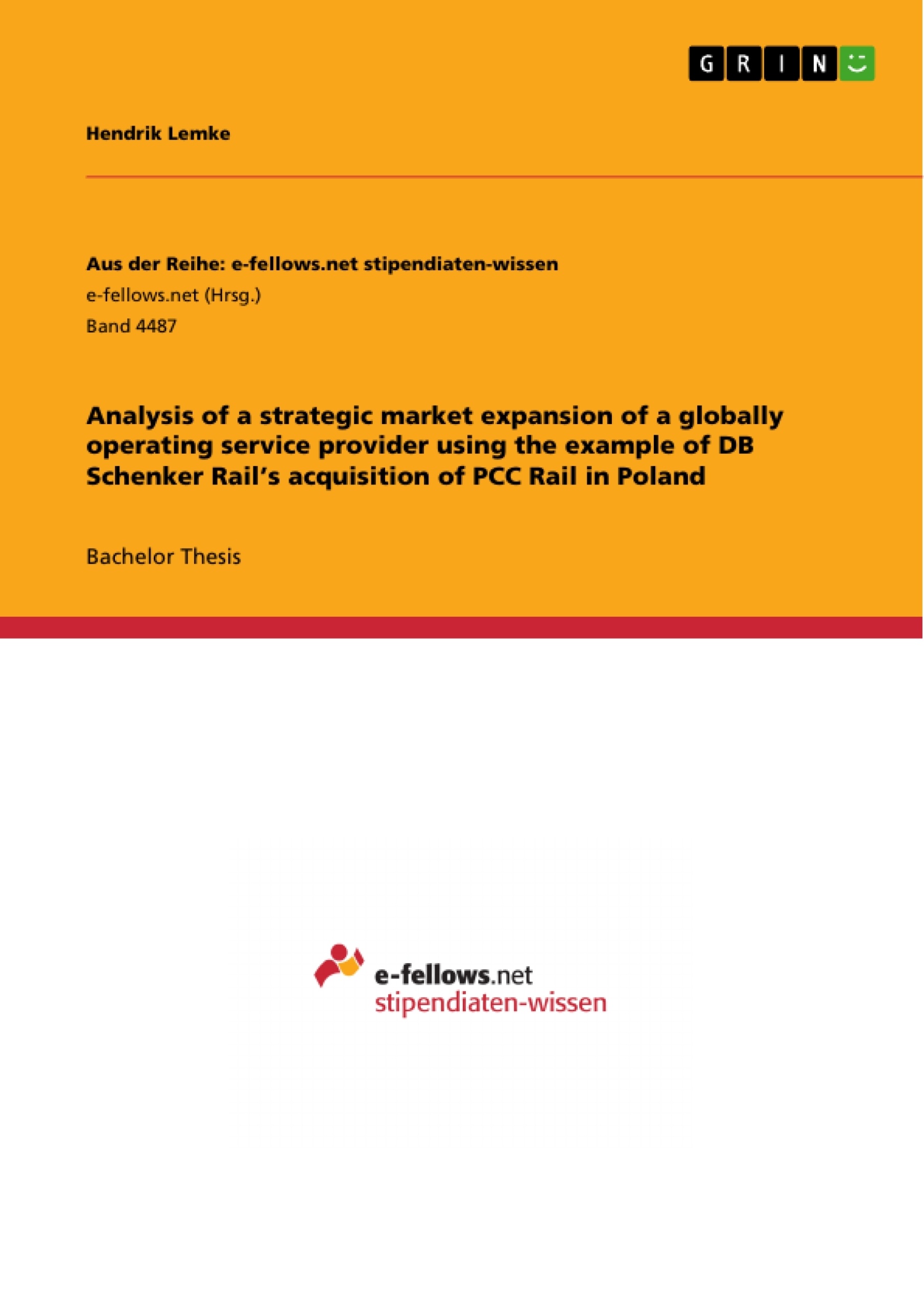The bachelor thesis at hand deals with the performance analysis of a globally operating service provider after a completed market expansion in an international context. This subject is elucidated by reference to the example of DB Schenker Rail’s entry into the Polish rail freight market through the acquisition of PCC Rail. First, the Polish rail freight market is analyzed from an industry perspective based on Michael Porter’s Five Forces model to identify the forces acting upon a company and the estimated profitability of the respective industry. Subsequently, a statement on whether the results of the overall industry are in alignment with the example DB Schenker Rail is made. The term profitability is operationalized through the introduction of the profit margin and the respective profit margins are checked against each other. By means of this result, and the inclusion of other quantitative and qualitative performance measures, a conclusive statement is made on whether DB Schenker Rail’s market entry in Poland can be considered a success.
Inhaltsverzeichnis (Table of Contents)
- I Introduction
- 1.1 Presentation of the Problem
- 1.2 Structure of the Thesis
- II Market Specifications and Developments in the Rail Logistics Sector using the Example of DB Schenker Rail.
- 2.1 Introduction to Logistics and Freight Traffic in Europe
- 2.2 Railway Logistics as a Sub-Industry of the Logistics Sector
- 2.2.1 Deep Dive – the Polish Railway History and Market at a Glance
- 2.2.2 Introduction of the Acquisition Parties – DB Schenker Rail and PCC Rail
- 2.2.3 Positioning of DB Schenker Rail on the Polish Market
- III Theoretical Foundation
- 3.1 Michael Porter's Five Forces Model
- 3.2 Determining the Success of a Company within the Industry
- IV Analysis of the Success of DB Schenker Rail's Market Expansion in Poland.
- 4.1 Assessment of Poland's Rail Freight Industry Structure using the Five Forces Model
- 4.1.1 Threat of New Entrants
- 4.1.2 Threat of Substitute Products or Services
- 4.1.3 Bargaining Power of Buyers
- 4.1.4 Bargaining Power of Suppliers
- 4.1.5 Rivalry Among Existing Competitors
- 4.1.6 Implications on the Intensity of the Five Forces in regard to DB Schenker Rail Polska
- 4.2 Analysis of the Success of DB Schenker Rail's Market Entry in Poland
- V Conclusion
Zielsetzung und Themenschwerpunkte (Objectives and Key Themes)
This bachelor thesis examines the performance of a global service provider following a completed market expansion in an international context. The thesis uses the example of DB Schenker Rail's entry into the Polish rail freight market through the acquisition of PCC Rail. The research analyzes the Polish rail freight industry based on Porter's Five Forces model, identifying market forces impacting companies and predicting industry profitability. It then compares the industry's overall performance with DB Schenker Rail's results, analyzing profitability using the profit margin. Finally, the study draws conclusions about the success of DB Schenker Rail's entry into the Polish market, employing both quantitative and qualitative performance measures.
- The impact of market forces on industry profitability
- Performance analysis of a globally operating service provider after a completed market expansion
- Application of Porter's Five Forces Model to analyze the Polish rail freight market
- Quantitative and qualitative assessment of DB Schenker Rail's market entry in Poland
- Determining the success of a market expansion based on profitability and performance metrics
Zusammenfassung der Kapitel (Chapter Summaries)
The first chapter introduces the topic of DB Schenker Rail's market expansion in Poland and outlines the structure of the thesis. Chapter two provides an overview of the European logistics and freight traffic sector, focusing on railway logistics. It delves into the history and current state of the Polish railway market and introduces the acquisition parties, DB Schenker Rail and PCC Rail. Chapter three lays the theoretical foundation for the analysis, focusing on Michael Porter's Five Forces Model and explaining how to assess the success of a company within an industry. Chapter four applies the Five Forces model to analyze the structure of the Polish rail freight industry, examining factors such as the threat of new entrants, substitute products, bargaining power of buyers and suppliers, and rivalry among existing competitors. It further analyzes the impact of these forces on DB Schenker Rail's performance in the Polish market.
Schlüsselwörter (Keywords)
This thesis focuses on the following key areas: market expansion, performance analysis, service provider, rail freight market, Poland, Porter's Five Forces Model, profitability, profit margin, qualitative and quantitative performance measures, DB Schenker Rail, PCC Rail, market entry, success assessment.
- Quote paper
- Hendrik Lemke (Author), 2013, Analysis of a strategic market expansion of a globally operating service provider using the example of DB Schenker Rail’s acquisition of PCC Rail in Poland, Munich, GRIN Verlag, https://www.grin.com/document/269542



